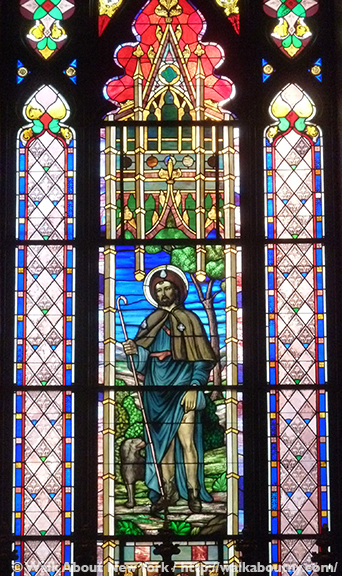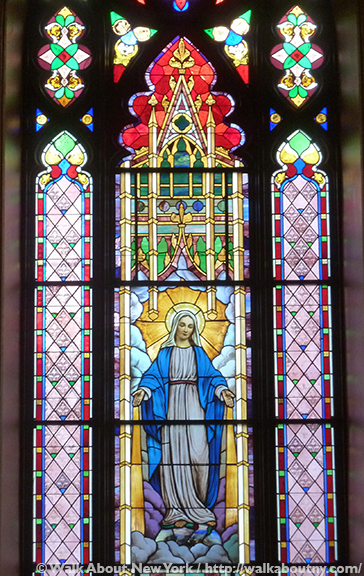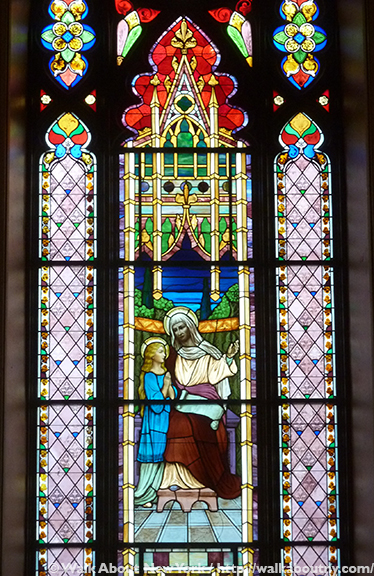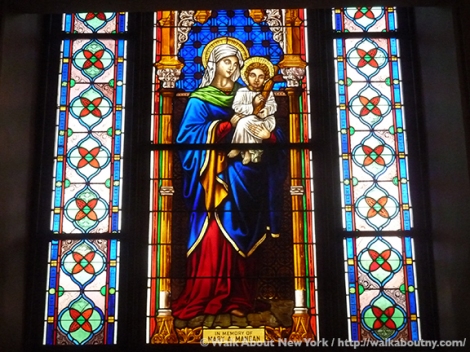“Should one Catholic come to harm, or should one Catholic business be molested, we shall turn this city into a second Moscow.” —from an 1835 letter Bishop John Hughes wrote to James Harper, mayor of the City of New York, when anti-Catholic mob violence threatened St. Patrick’s Cathedral
The Know Nothing Party, a Nativism political party active in the 1830s and 1840s, organized Protestants to march on St. Patrick’s Cathedral. In 1835 it was necessary for the church to gather its parishioners to defend the Cathedral against vigilantes, determined to “burn her to the ground.” The hooligans combined their anti-Catholic and anti-Irish feelings by chanting “Paddies of the Pope.”
With its cornerstone laid on June 8th 1809, St. Patrick’s Cathedral became the first cathedral of the Diocese of New York. Located on the corner of Mott and Prince Streets, it has stood as a beacon for Roman Catholics and as a symbol of religious freedom in America in the heart of old New York. Originally the church served the area’s impoverished Irish community; over the years Old St. Pat’s went on to serves a diverse community of Catholics from Italian, Hispanic, Asian, and other heritages. Today, the Basilica of St. Patrick’s Old Cathedral remains a vital force in the community, proudly serving Catholics through worship, social groups and spiritual guidance.
Pope Pius VII (1742–1824) created the first cathedral church for the Diocese of New York in 1808; it was the second Catholic church in Manhattan, and third Catholic church in New York State. Joseph-Francois Mangin (1758–1815), designed Old St. Pat’s, as well as New York City’s City Hall. It was the largest Roman Catholic church in the United States when it was dedicated on May 14th 1815. The area around the Cathedral was rural enough at the time that a fox was caught in the churchyard not long after it was completed.
The first American bishop to be canonized, John Neumann (1811–1860) was ordained at the Old Cathedral in 1836. In 1838 a requiem mass was held at Old St. Pat’s for Lorenzo Da Ponte (1749–1838). He had been the librettist for Don Giovanni, The Marriage of Figaro and Così fan tutte, three of Wolfgang Amadeus Mozart’s best-known operas. Signore Da Ponte was also the first professor of Italian Literature and Language at Columbia University.
The properties owned by the Cathedral formed a campus complex. In 1808 the New York Literary Institution, founded by Anthony Kohlmann, S.J., was the first school for boys in New York. Making up part of the complex, 32 Prince Street became the site for the first mission of the Sisters of Charity in New York in 1817. St. Elizabeth Ann Seton, the first American-born saint, founded this order of nuns. A building constructed within the campus in 1826 would be the first structure designed and purposely built as a Catholic school in New York City. Before this schools had used church basements or repurposed buildings. This was New York City’s oldest existing Catholic grammar school, operating until it was closed in 2010.
The first priest ordained in New York City was Rev. Richard Bulger; the ordination took place at St. Patrick’s in 1820. Before the “Fighting” 69th Infantry Regiment left for active duty in the Civil War on April 23, 1861, Archbishop John Hughes (1797–1864) blessed its colors. Known as an “Irish Brigade,” whose ranks included many parishioners from the Old Cathedral, including former Congressman, U.S. Attorney and Abolitionist, Captain John McKeon, the Regiment saw action at the Battle of Bull Run and other battles.
Dominick Lynch (1754–1844), a wealthy wine importer and an Irish immigrant, was a founding trustee of Old St. Pat’s; he is buried in the crypt beneath the Old Cathedral. He attended the inauguration of George Washington at Federal Hall on Wall Street, and signed the Address of Congratulations to the President Washington from the Roman Catholic community in America. Mr. Lynch owned the town of Lynchville, New York State; it was re-named Rome, New York.
Andrew Morris (1752–1828), the first Roman Catholic to be elected to public office in the City of New York as Assistant Alderman of New York’s First Ward, and in the State of New York as an Assemblyman representing New York City, is buried in the Cathedral’s cemetery. He had been a founding trustee of St. Patrick’s Cathedral and a member of the Friendly Sons of St. Patrick in the City of New York.
Brigadier General Thomas Eckert (1825–1910) was a personal friend and confidant of President Abraham Lincoln. He was buried in an vault in the crypt beneath the Old Cathedral in October 1910. Timothy “Big Tim” Sullivan (1862–1913) was a politician associated with the infamously corrupt Tammany Hall. His funeral brought 25,000 onlookers to the streets surrounding the Old Cathedral.
Annie Leary (1832–1919) took to philanthropy in a major way when she inherited her brother Arthur’s fortune. When she died in 1919 she left $200,000 to the Archdiocese of New York to build a new sacristy and a burial vault for herself and her family at St. Patrick’s Cathedral. The executrix of the will was a niece, who did not give the money as the will directed. After a legal challenge ended there was no money remaining to build the burial vault. Miss Leary remained buried at the Old Cathedral. Pope Leo XIII created Miss Leary a Papal Countess, the first such title given to American, in 1903.
The Venerable Pierre Toussaint, a Haitian-born slave who eventually won his freedom, was a successful hairdresser in New York City. Among his clients were Catherine Cruger, the daughter of John Barker Church, whose pistols were used by Alexander Hamilton for his duel with Aaron Burr in Weehawken, and Angelica Schuyler, sister-in-law to Hamilton. When Toussaint died in 1853 he was buried in the Old St. Pat’s churchyard; in 1990 his remains are moved to the Cathedral of St. Patrick uptown. Because of Toussaint’s charity toward children, priests and immigrants he has been advanced for sainthood; in 1996 Pope John Paul II declared him “venerable,” a preliminary step on the road to canonization.
At the Old Cathedral the funeral and burial of Archbishop John Hughes in January of 1864 attracted thousands, among them were many prominent New York City and New York State political figures. The archbishop’s remains are removed later to the Cathedral of St. Patrick uptown. Entombed in the crypt of Old St. Pat’s is the Delmonico Family. Francis Delmonico (1802–1840) was the founder and operator of a number of restaurants in New York City the carried his family’s name. They were New York’s first fine dining experience, catering to celebrities, such as Mark Twain and many prominent New Yorkers throughout the 19th century and well into the 20th.
On October 6, 1866 a fire destroyed the Old Cathedral’s interior; it was rebuilt and re-opened on the Feast of St. Patrick, March 17th 1868. In public ceremony, attended by future president Chester A. Arthur, at the Old Cathedral, John Cardinal McCloskey (1810–1885) was installed as the first American cardinal in April of 1875. On May 25, 1879 the Archdiocese of New York got a new seat for its archbishop when the “new” Cathedral of St. Patrick on Fifth Avenue superseded St. Patrick’s Old Cathedral, which was consecrated, March 17, 1885 after its debt was finally paid off.
Old St. Pat’s and its campus complex buildings were among the first sites to be designated as New York City landmarks in 1966 by the recently formed Landmarks Preservation Commission. Eleven years later they were listed on the National Register of Historic Places. His Holiness Pope Benedict XVI, on the Feast of St. Patrick, March 17th 2010, designated the Old Cathedral a Basilica.
Read our article, Stained Glass Windows of St. Patrick’s for a view of the stained glass windows at the new Cathedral of St. Patrick on Fifth Avenue between E. 50th and E. 51st Streets. To learn about other stained glass we have written about read Tiffany’s Stained Glass “Autumn” and Stained Glass, For the Law and Learning.
Our guided walking tours are filled with beautiful art and architecture. Our Art of Rockefeller Center Walking Tour begins on the steps of the Cathedral of St. Patrick at Fifth Avenue and 50th Street, which was a bastion of upper-crust Episcopalians in the 1870s when it was built. The new cathedral was a purposeful poke in the eye to New York’s social elite! Take the Tour; Know More!
ALL PHOTOS AND TEXT, EXCEPT CREDITED QUOTES, © THE AUTHOR 2018

















Excellent stained glass photos. Thank You.
LikeLike
Thank you for visiting Walk About New York’s website, and for the kind words about our photos of the stained glass windows at Old St. Pat’s.
LikeLiked by 1 person